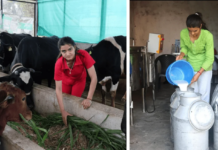New Delhi, July 27, 2021: The latest milk production report from USDA brought some good news, with a slowing of the milk spigot. June’s milk production was up 2.9% year-over-year after increasing 4.7% year-over-year in May.
Even though May’s milk production was gauged against a low comparable — with May 2020 being up only 0.8% year over year — June’s output was quite an improvement when it comes to slowing milk production, said Bob Cropp, an economist with the University of Wisconsin.
More good news is that cow numbers in June showed a slight decline from May after increasing monthly since July 2020. There are still a lot of cows, about 153,000 more than a year ago, but production per cow was more normal with only a 1.3% increase year-over-year, he said during the latest “Dairy Situation and Outlook” podcast.
“It is an improvement but, boy, we’ve had a head of steam up and we still have a lot of cows,” said Mark Stephenson, fellow economist at the university.
But there have been all kinds of problems in the West with heat, drought, fires and water rationing, he said, and he wonders if production levels will hold in the region.
The Midwest is now seeing heat as well, and the feed situation is not good. Large herds have nutritionists who can balance rations to temper the impact, but the heat will have an impact, Cropp said.
“So I look for milk production to continue to slow, which I hope it does,” he said.
He expects cow numbers to decrease slowly, but maybe not until next year, he said
“But I’m a little concerned about margins on farms, particularly those farms in the West,” he said.
If they’re not able to water and harvest alfalfa, purchasing it is going to be expensive. The same goes for other crops, he said.
“Those margins are looking pretty tight. We’ll have to see what that does for milk production,” he said.
There’s a lot of uncertainty, but USDA is forecasting a 2.5% increase in milk production this year. That’s a lot of milk, and it’s going to keep pressure on milk prices, Cropp said.
But milk production does decrease seasonally in the summer. Things getting back to normal with in-person school and events should help demand. Dairy exports have been doing great, and the holidays should bring a boost in demand for butter and cheese, he said according to the reports published in capitalpress.com.
July’s Class III milk prices are looking like they’ll be in the low $16 a hundredweight, down from $17 in June and more than $18 in May. But the cheese market has really taken a hit in the last couple of weeks. If cheese prices don’t improve, Class III milk could drop below $16, he said.
But if milk production continues to slow, schools and event get back to normal and exports stay strong, he expects Class III milk to get in the $17 by October. If milk production slows even more, prices could move into the high $17s, he said.

































